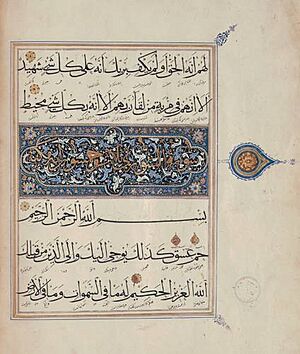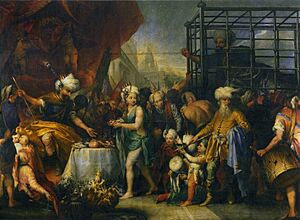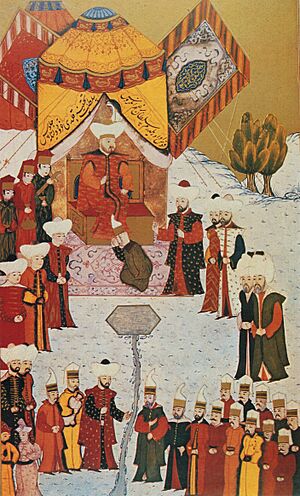Bayezid I facts for kids
Quick facts for kids Bayezid I |
|||||
|---|---|---|---|---|---|
|
|||||

Bayezid I by Cristofano dell'Altissimo, c. 16th century
|
|||||
| Sultan of the Ottoman Empire (Padishah) | |||||
| Reign | 16 June 1389 – 20 July 1402 | ||||
| Predecessor | Murad I | ||||
| Successor |
Interregnum (1402 – 1413)
|
||||
| Born | c. 1360 Ottoman Beylik |
||||
| Died | 8 March 1403 (aged 42) Akşehir, then under Timurid occupation |
||||
| Burial | Bayezid I Mosque, Bursa | ||||
| Consorts | Devletşah Sultan Hatun Devlet Hatun Olivera Despina Lazarević Hafsa Hatun Maria Fadrique Others |
||||
| Issue Among others |
Fatma Hundi Hatun Süleyman Çelebi İsa Çelebi Musa Çelebi Mustafa Çelebi Mehmed I |
||||
|
|||||
| Dynasty | Ottoman | ||||
| Father | Murad I | ||||
| Mother | Gülçiçek Hatun | ||||
| Religion | Sunni Islam | ||||
| Tughra |  |
||||
Bayezid I (born around 1360 – died March 8, 1403) was an important ruler of the Ottoman Empire. He was the Sultan from 1389 to 1402. People also knew him as Bayezid the Thunderbolt because he was very quick and strong in battle.
During his rule, Bayezid expanded the Ottoman Empire a lot. He defeated Christian armies at the Battle of Nicopolis in 1396. He also worked to unite different Turkish states in Anatolia under his control. However, his reign ended when he was defeated and captured by the powerful Mongol leader Timur at the Battle of Ankara in 1402. He died while being held captive in 1403. His defeat led to a difficult period for the Ottoman Empire called the Ottoman Interregnum, where his sons fought for the throne.
Contents
Becoming Sultan
Bayezid was the son of Murad I, who was the previous Ottoman Sultan. His mother was a Greek woman named Gülçiçek Hatun. Before becoming Sultan, Bayezid was the governor of Kütahya. He got this position after marrying Devletşah Hatun, the daughter of a local ruler.
He earned his nickname "Thunderbolt" because of his fierce fighting style. This happened during a battle against another Turkish group called the Karamanids.
In 1389, Bayezid's father, Murad I, died during or right after the Battle of Kosovo. This battle made Serbia a state that had to obey the Ottoman Sultan. After his father's death, Bayezid became the new Sultan. To make sure his rule was secure, he took steps to prevent any challenges from his younger brother.
In 1390, Bayezid married Princess Olivera Despina. She was the daughter of Prince Lazar of Serbia, who also died at Kosovo. Bayezid allowed Lazar's son, Stefan Lazarević, to lead Serbia with a lot of freedom. In 1391, Bayezid captured Skopje in Serbia, making it a key base for his army.

Expanding the Empire
Bayezid wanted to bring all of Anatolia (modern-day Turkey) under Ottoman control. He conquered many smaller Turkish states, called beyliks. In 1390, he quickly took over the beyliks of Aydin, Saruhan, and Menteshe.
His main rival was Sulayman, the ruler of Karaman. Sulayman teamed up with other Turkish leaders to resist Bayezid. But Bayezid kept pushing forward. He conquered more beyliks like Hamid, Teke, and Germiyan. He also captured important cities like Akşehir, Niğde, and Konya from Karaman.
Bayezid made peace with Karaman in 1391. He then moved north and conquered Kastamonu and Sinop.
From 1389 to 1395, Bayezid also conquered parts of Europe. He took over Bulgaria and northern Greece. In 1394, he attacked Wallachia (part of modern-day Romania). Even though the Ottomans had more soldiers, the Wallachians won the Battle of Rovine. This stopped Bayezid's army from going further into Europe.
In 1394, Bayezid began a long siege of Constantinople, the capital of the Byzantine Empire. He built the Anadoluhisarı fortress as part of his plans to capture the city. The Byzantine emperor asked for help, and a new Christian army was formed to fight Bayezid.
This Christian army was defeated in 1396 at the Battle of Nicopolis. This battle took place in what is now Bulgaria. The Christian forces were led by Sigismund, the King of Hungary. To celebrate this big victory, Bayezid built the beautiful Ulu Cami in Bursa.
The siege of Constantinople continued until 1402. The Byzantines got a break when Bayezid had to face a new threat from the east. At this time, Bayezid's empire was very large. It included parts of Europe like Thrace, Macedonia, Bulgaria, and Serbia. In Asia, his lands reached the Taurus Mountains. His army was considered one of the strongest in the Islamic world.
Facing Timur

In 1397, Bayezid defeated the ruler of Karaman again, taking over his land. In 1398, he conquered more territories, which upset a powerful Turco-Mongol leader named Timur. Timur was a great conqueror, and he saw Bayezid as a rival.
Timur encouraged the Turkish states that Bayezid had conquered to join him. For years, Timur and Bayezid exchanged insulting letters. They both tried to show who was more powerful.
In the important Battle of Ankara, on July 20, 1402, the Ottoman army was defeated by Timur's forces. Bayezid tried to escape, but he was captured and taken to Timur.
Historians describe their first meeting: Timur reportedly laughed when he saw Bayezid. Bayezid was offended and said it was wrong to laugh at someone's misfortune. Timur replied, "It is clear that fate does not value power if it gives it to people with flaws: to you, who are crooked, and to me, who is lame."
Many stories say that Bayezid was treated badly by Timur. However, writers from Timur's own court said that Bayezid was treated well. They even said Timur was sad when Bayezid died. One of Bayezid's sons, Mustafa Çelebi, was captured with him. He was held in Samarkand until 1405.
Four of Bayezid's other sons, Süleyman Çelebi, İsa Çelebi, Mehmed Çelebi, and Musa Çelebi, managed to escape the battle. They later started a civil war to become the next Sultan. This period is known as the Ottoman Interregnum. After many years, Mehmed I won and became Sultan.
Bayezid in Captivity
In Europe, many legends grew about Bayezid's time in captivity. Some stories claimed he was chained and forced to watch his wife, Olivera, serve Timur at dinner. Other legends said Timur carried Bayezid everywhere in a barred cage or a special chair called a palanquin. These stories claimed Timur humiliated Bayezid in many ways, even using him as a footrest.
There were also different stories about how Bayezid died. Some said he took his own life. Others claimed Timur poisoned him. However, this is unlikely because there is evidence that Timur had his personal doctors take care of Bayezid.
Writers who were alive at the time and saw the events did not mention a cage or any harsh treatment. For example, the German traveler Johann Schiltberger and the French knight Jean II Le Maingre did not write about a cage or a violent death. A Spanish traveler named Clavijo, who visited Timur's court in 1404, also did not mention a cage. Greek sources from that time also do not mention a cage.
A historian named Sharaf ad-Din Ali Yazdi wrote that Bayezid was treated with respect. He even wrote that Timur found Bayezid's son among the captives and brought him to his father. Regarding Bayezid's wife, Sharafaddin wrote that Timur sent her and his daughters to her husband.
The first stories about disrespectful treatment of Bayezid appeared in later writings. One writer, ibn Arabshah, wrote that "Bayezid's heart was broken" when he saw his wives serving at a banquet. He also wrote that "Ibn Usman became a prey and was locked up like a bird in a cage." However, historians believe this was a way of speaking, not a literal cage.
An Ottoman historian named Mehmed Neshri (1450–1520) did describe Bayezid's imprisonment and mentioned a cage twice. According to Neshri, Timur asked Bayezid what he would do if Timur were his captive. Bayezid supposedly replied, "I would have put him in an iron cage." Timur then ordered a cage to be made and put Bayezid in it.
More detailed legends, including Bayezid being fed scraps under the table and used as a support to get on a horse, appeared in later works, like one written by Pope Pius II around 1450–1460. Later versions of these stories also included descriptions of Bayezid's wife being publicly humiliated.
Family
Bayezid I had many wives and children.
Wives
Bayezid I had at least nine wives:
- A daughter of Konstantin Dejanović, whom he married in 1372.
- Devletşah Sultan Hatun (born around 1365 – died 1414). She was the daughter of Süleyman of Germiyan. They married in 1378.
- A daughter of John V Palaiologos, the Byzantine Emperor. They married in 1386.
- Devlet Hatun (died 1422). She was a slave and the mother of Mehmed I.
- Maria Olivera Despina Hatun (1372 – 1444). She was a Serbian princess and married Bayezid in 1390. She was Bayezid's favorite wife. She was captured by Timur with her husband.
- Hafsa Hatun. She was the daughter of Isa of Aydin and married Bayezid in 1390.
- Maria Fadrique (1370 - 1394). She joined Bayezid's harem in 1393 or early 1394. She died in 1394 or 1395.
- Angelina Hatun. A Greek noblewoman, she was freed by Timur.
- Maria Hatun. Daughter of a Hungarian count, she was also freed by Timur.
Sons
Bayezid I had at least twelve sons:
- Ertuğrul Çelebi (1376 –1400). He was a governor and fought in battles. He died of unknown causes.
- Süleyman Çelebi (1377 - 1411). He claimed the Ottoman throne during the civil war after Bayezid's death.
- İsa Çelebi (1380 - 1403). He was a governor and also claimed the throne during the civil war.
- Mustafa Çelebi (1380 – 1402 or 1422?). He claimed the throne during the reigns of his brothers.
- Musa Çelebi (died 1413). He was a governor and also claimed the throne during the civil war.
- Mehmed I (born around 1386–1421). He was a governor and eventually won the civil wars to become Sultan.
- Yusuf Çelebi. He was sent as a hostage to Constantinople and later became Christian.
- Kasım Çelebi. He was also sent as a hostage to Constantinople.
- Hasan Çelebi. He was a child when his father died and was killed during the civil wars.
- Ömer Çelebi.
- Korkud Çelebi.
- Ibrahim Çelebi.
Daughters
Bayezid I had at least five daughters:
- Fatma Hundi Sultan Hatun (1375–1430). She married Amir Sultan in 1390.
- Erhundi Hatun. She married Yakup Bey.
- Öruz Hatun. She married Abu Bakr Mirza in 1403.
- Paşa Melek Hatun. She married Şemseddin Mehmed in 1403 in Samarkand.
- Fatma Hatun (1393–1417). She was sent as a hostage to Constantinople.
Personality
Historians describe Bayezid as a quick-tempered and impulsive person. He was known for being unpredictable. He often left state matters to his governors and enjoyed pleasures between military campaigns. His court was famous for its luxury.
Despite his love for enjoyment, Bayezid was a very skilled military leader. In his 13 years as Sultan, he only suffered one major defeat, which was the Battle of Ankara. This defeat was very important for his rule. Bayezid was also a religious man. He spent many hours in his personal mosque in Bursa and kept Islamic scholars close to him.
A Greek historian named Doukas, who lived at the same time, wrote that Bayezid was a feared man. He was very quick in war and was a strong follower of Islam. He worked to increase the power of the Muslim people and decrease the power of the Christian Romans. He added many cities and regions to the Ottoman Empire.
Impact of His Rule
Bayezid successfully expanded the Ottoman Empire's territory. His lands stretched from the Danube River in Europe to the Euphrates River in Asia. However, his reign ended with a major defeat at Ankara. This battle greatly reduced the size of the Ottoman Empire.
After the defeat, the empire was divided between Bayezid's sons by Timur. Many smaller Turkish states that Bayezid had conquered regained their independence. The defeat at Ankara also started the Ottoman Interregnum, a civil war among his sons that lasted for 10 years.
Bayezid in Stories and Art

Bayezid's defeat became a popular topic for writers, composers, and painters in Western Europe. They often added to the legends about his captivity. For example, Christopher Marlowe's play Tamburlaine the Great (1587) showed Timur and Bayezid.
Later, operas like Handel's Tamerlano (1725) and Vivaldi's Bajazet (1735) told the story. These works often included romantic plots with other characters. Paintings in places like Schloss Eggenberg in Austria also showed this theme.
Bayezid also appears in historical novels. He is a main character in The Grand Cham (1921) by Harold Lamb and Lord of Samarcand by Robert E. Howard. In some stories, he dies by his own hand. He is also a character in the novel The Walls of Byzantium (2013) by James Heneage.
Images for kids
-
The Battle of Nicopolis, as depicted by an Ottoman Turkish miniaturist in 1588
See also
 In Spanish: Bayezid I para niños
In Spanish: Bayezid I para niños





